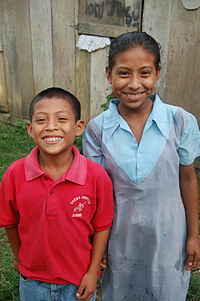Childhood in Maya society
For instance, at a very young age boards were pressed on babies' foreheads to create a flattened surface.Every day of the year had a specific name for both boys and girls and parents were expected to follow that practice."[6] It is believed that the most important quality for children to have was common sense, and they received this by shadowing their parents.Among Yucatec Maya parents, the ceremony called hetsmek' is still practiced even among professionals living in Mérida, the capital of Yucatán.Maya populations are present today in many areas of Central and South America, such as Guatemala.[7] However, the goals for Maya children's socialization and daily activities differ from those of other cultures, especially those that are most studied.[9] Children in modern-day Maya communities observe and participate in work with people of all ages.This individual drive to learn is coupled with the learner's expected participation in shared endeavors.Assembly-line instruction is based on the transmission of knowledge from experts to subordinates, in a way that does not facilitate purposeful activity.
Young girlshouseholdfathersfarmingwork ethicforeheadsupper classburialethicsimperativecommon senseYucatec Maya parentsMéridaYucatánsocializationSan Pedro La LagunaAge segregationAnnual Review of PsychologyMaya civilizationHistoryPreclassic MayaClassic Maya collapseSpanish conquestChiapasGuatemalaPeténArchitectureE-GroupTriadic pyramidTwin-pyramid complexRevivalGraffitiCeramicsCitiesCuisineEconomyMaritime tradeLanguagesClassicScriptMayanistMedicineMythologyNumeralsPeopleStelaeTextilesWarfareSocietyMidwiferyReligionPriesthoodSacrificeHuman sacrificeDeath ritualsSocial classesHouseholdsCalendarBaktunHaabʼKʼatunTzolkʼinAnnals of the CakchiquelsChilam BalamCodicesDresdenGrolierMadridPopol VuhRabinal AchíRitual of the BacabsSongs of DzitbalchéTítulo CʼoyoiTítulo de TotonicapánDeitiesDeath godsGoddess IHero TwinsHowler monkey godsItzamnaIxchelJaguar godsKʼawiilKinich AhauMaize godMoon goddessYopaatAh-Muzen-CabKukulkanYum KaaxAwilixCamazotzHun HunahpuHuracanJacawitzQʼuqʼumatzVucub CaquixXmucane and XpiacocZipacnaBʼalaj Chan KʼawiilHaʼ Kʼin XookItzam Kʼan Ahk IIKʼakʼ Tiliw Chan YopaatKʼinich Janaabʼ PakalKʼinich Yat Ahk IIKʼinich Yax Kʼukʼ MoʼKʼinich Yoʼnal Ahk IUaxaclajuun Ubʼaah KʼawiilYoʼnal Ahk IIIYuknoom Chʼeen IIYuknoom Yichʼaak KʼahkʼQueensLady EveningstarLady of ItzanLady of TikalLady XocSak KʼukʼWak Chanil AjawYohl Ikʼnal